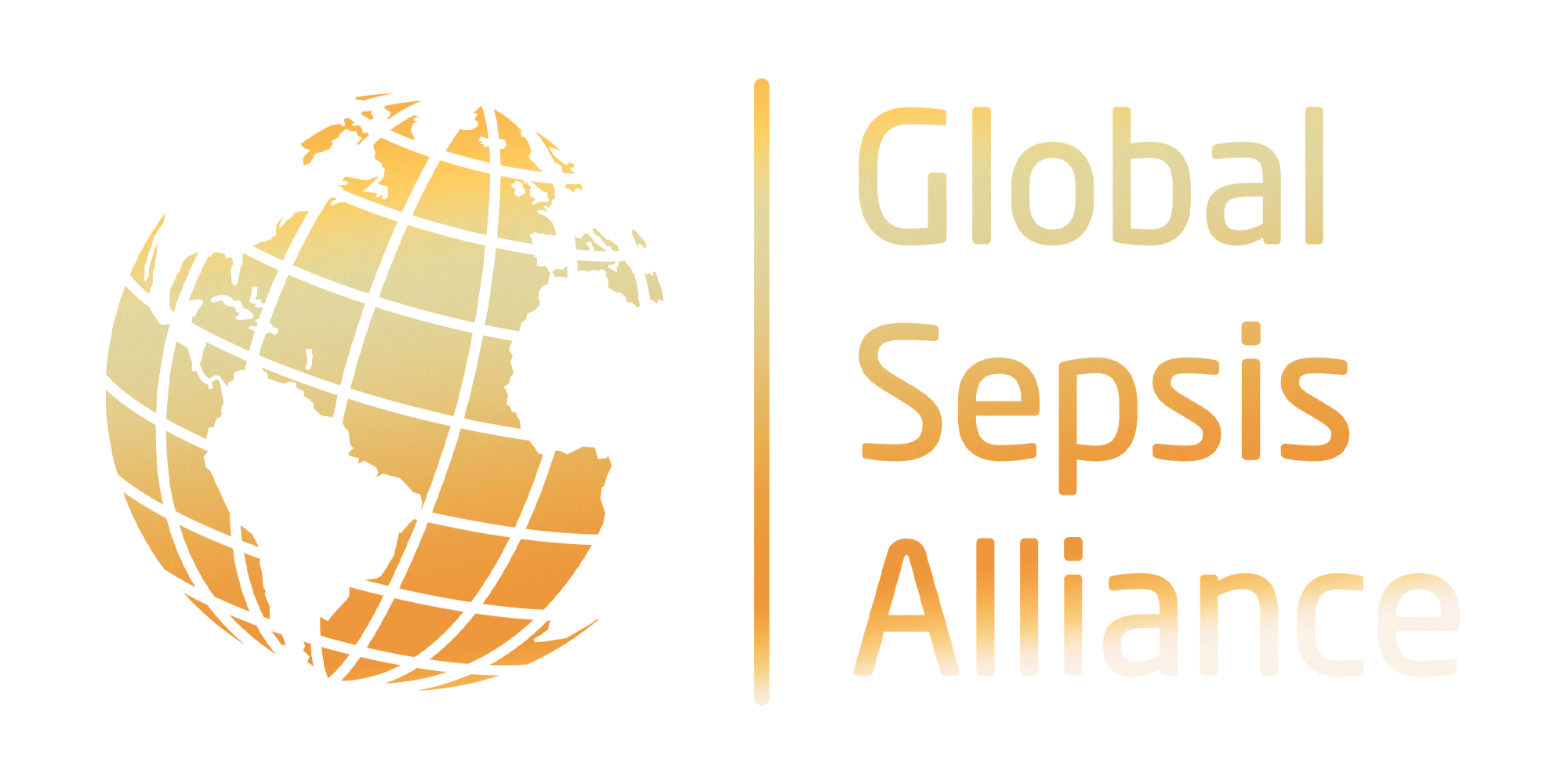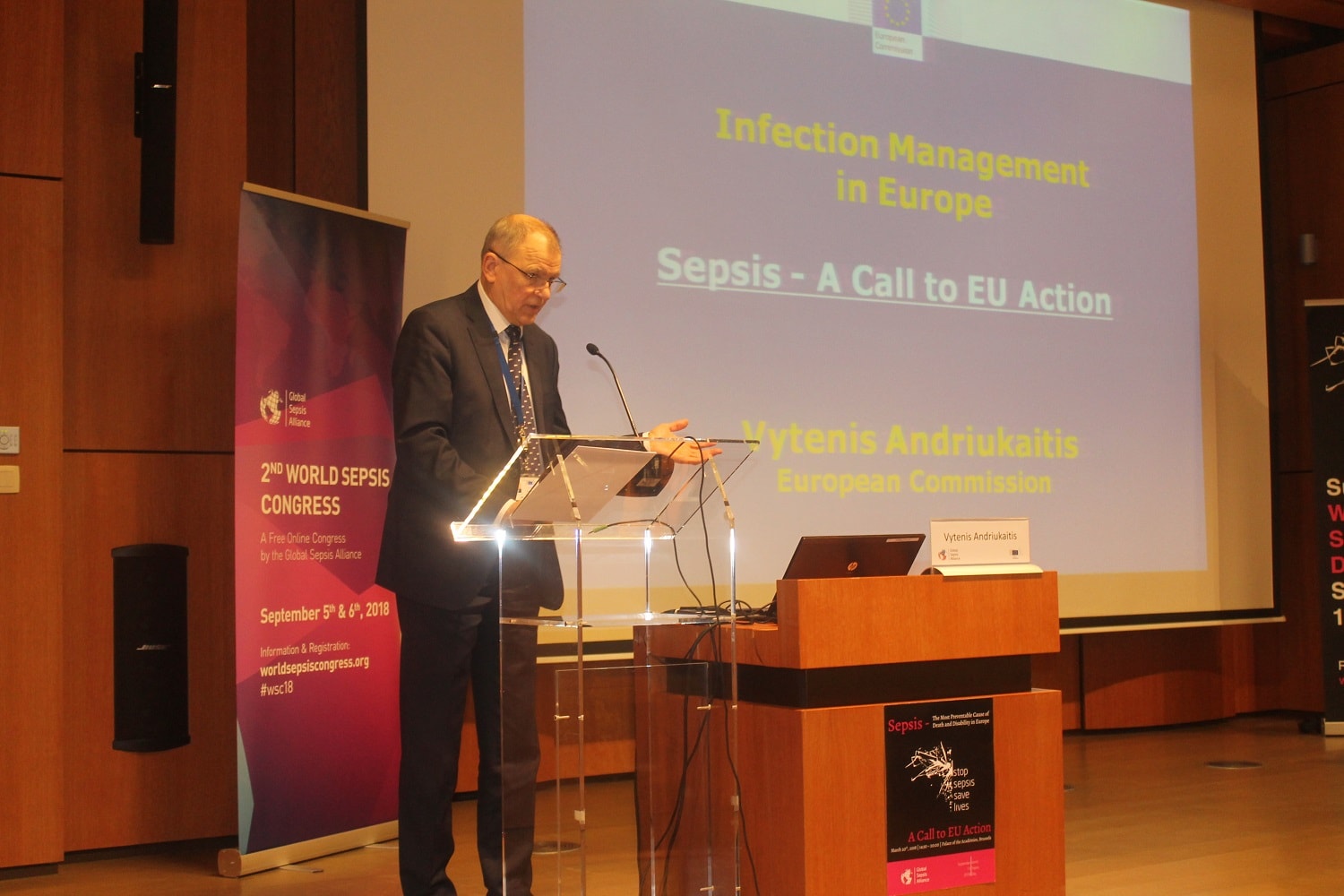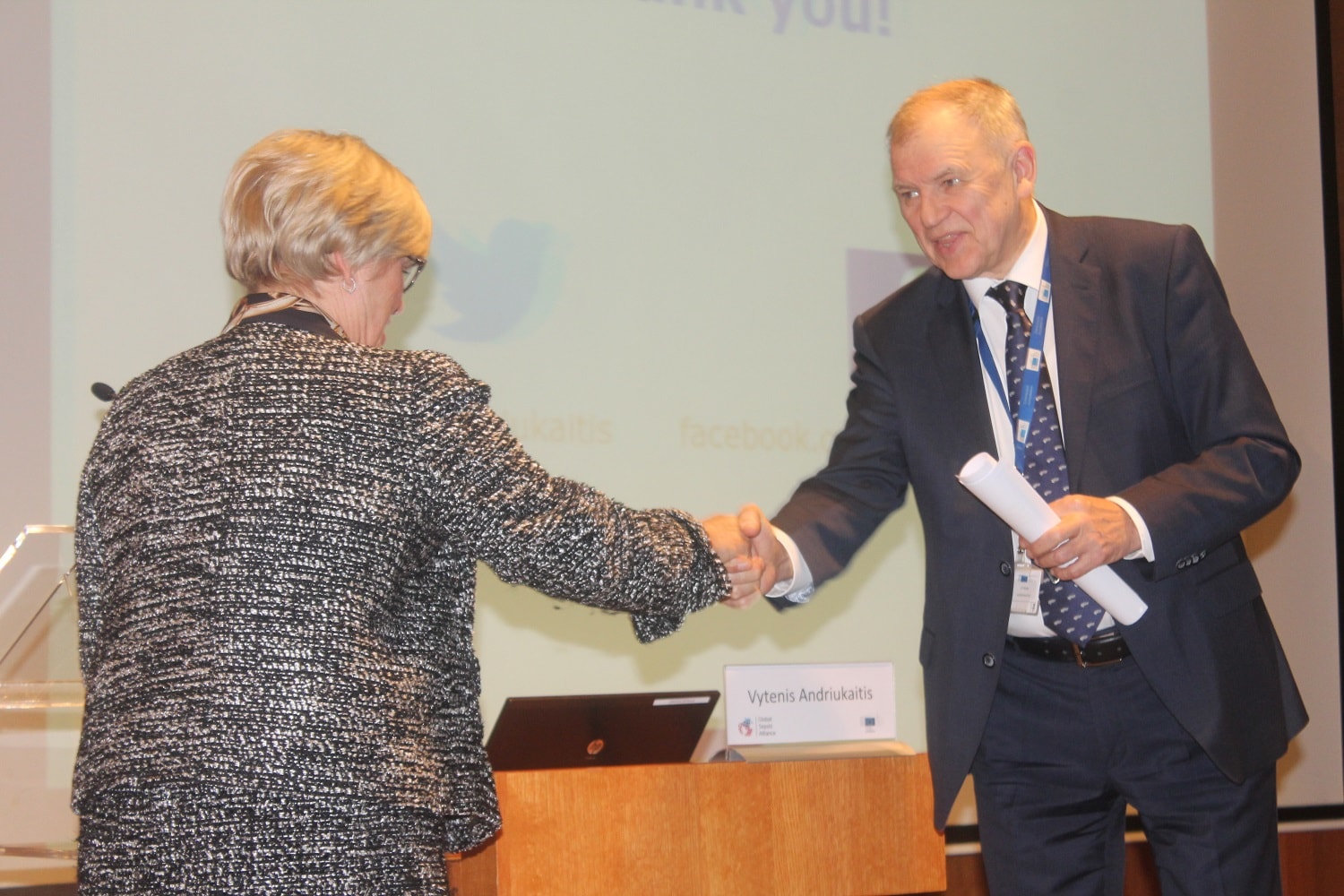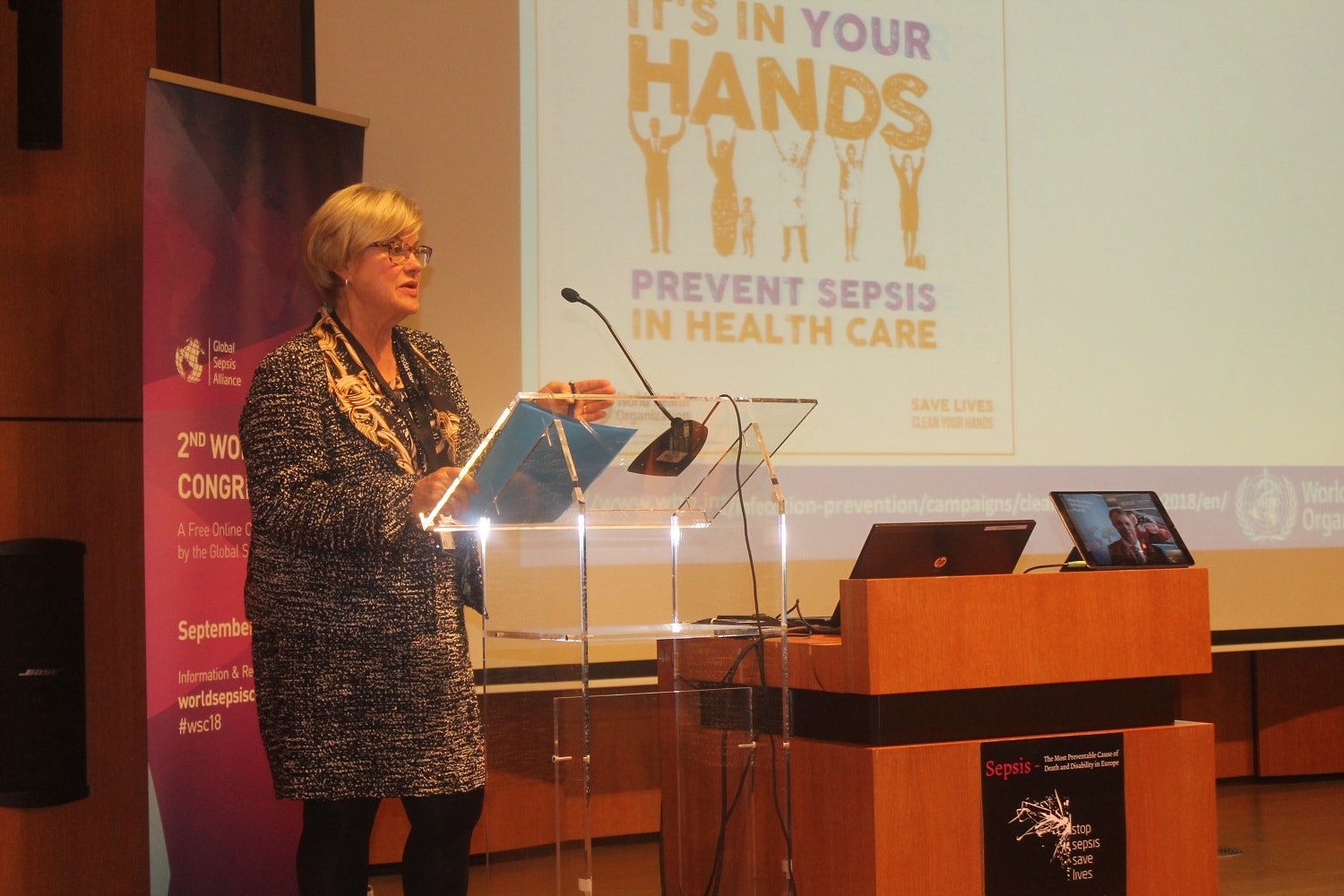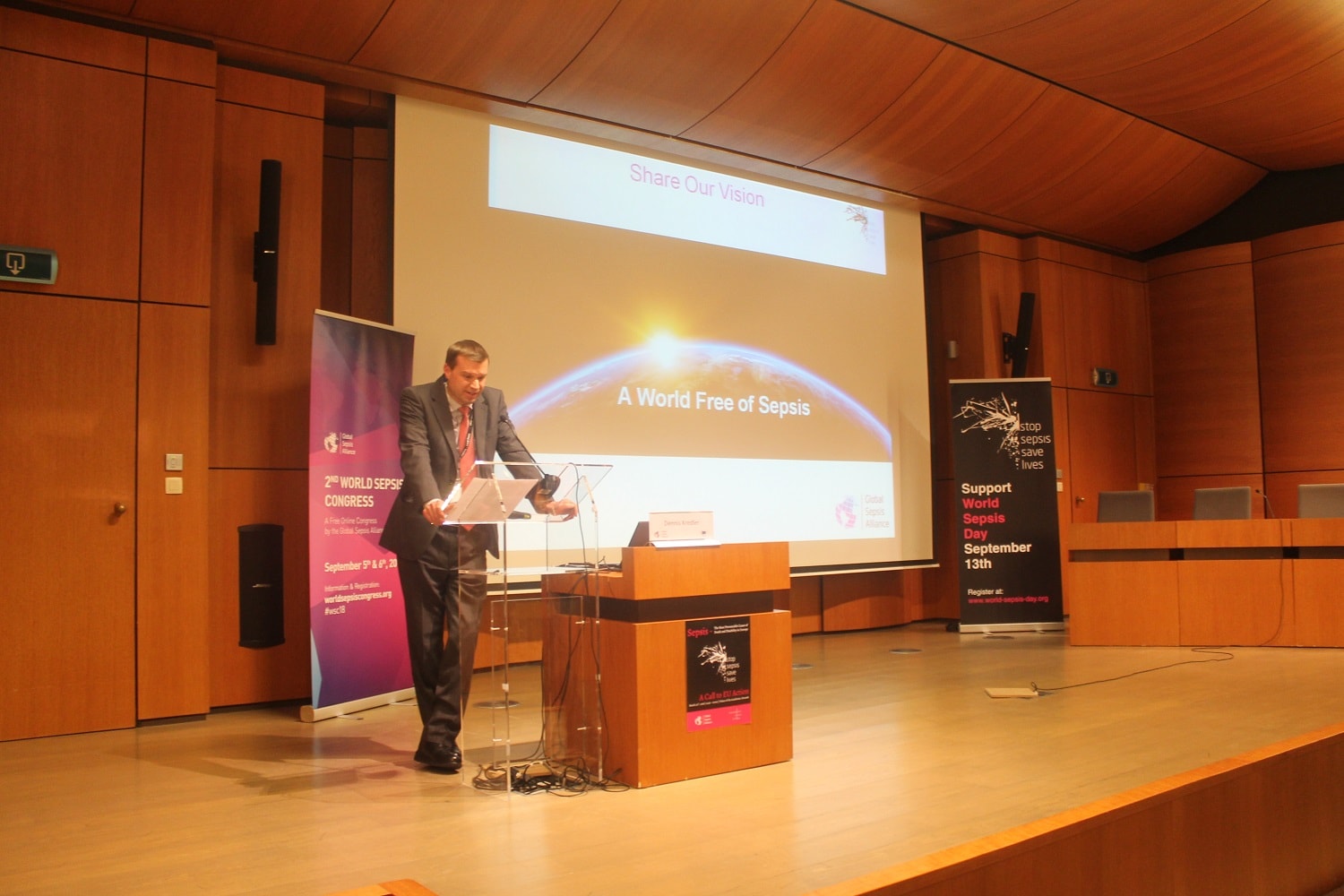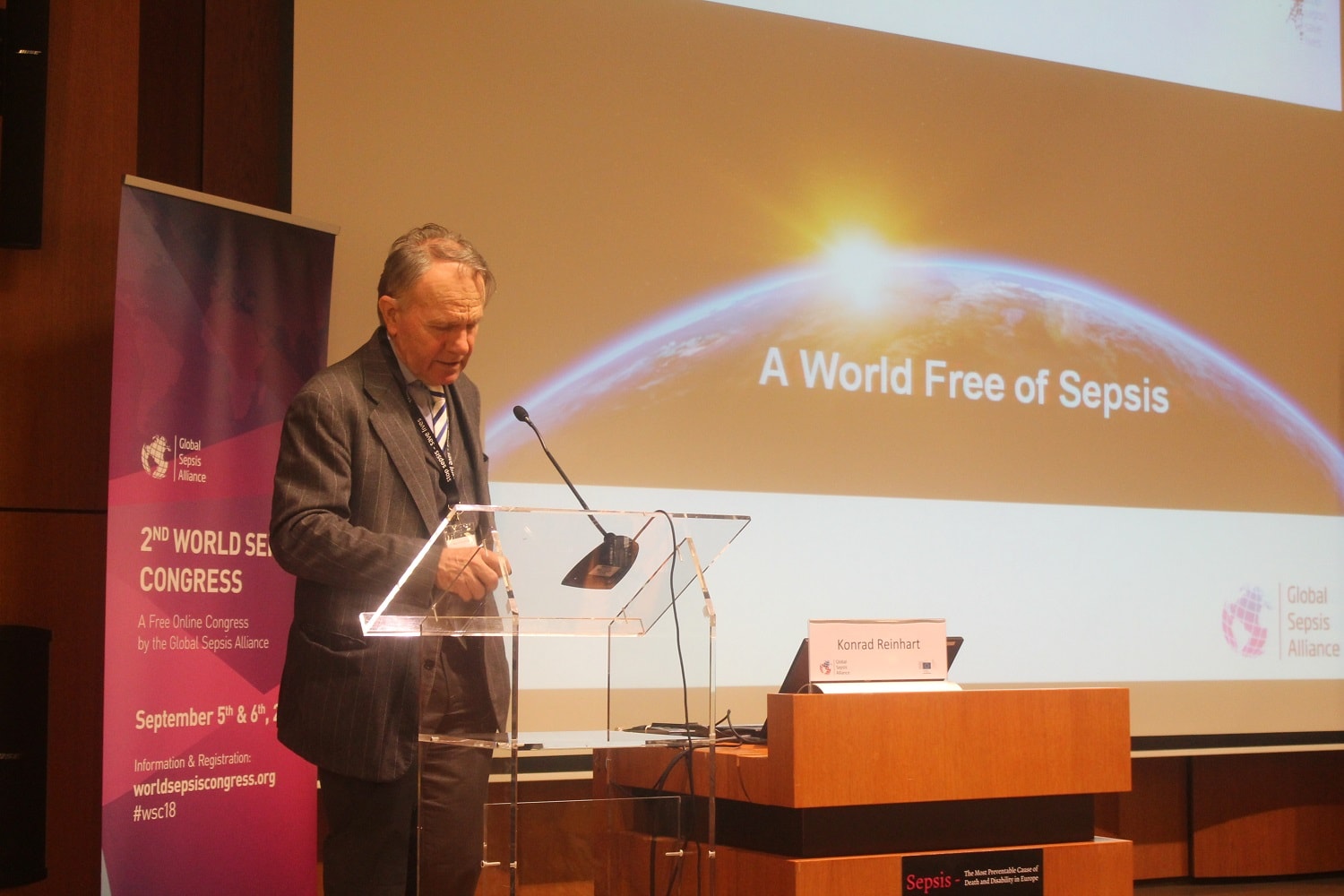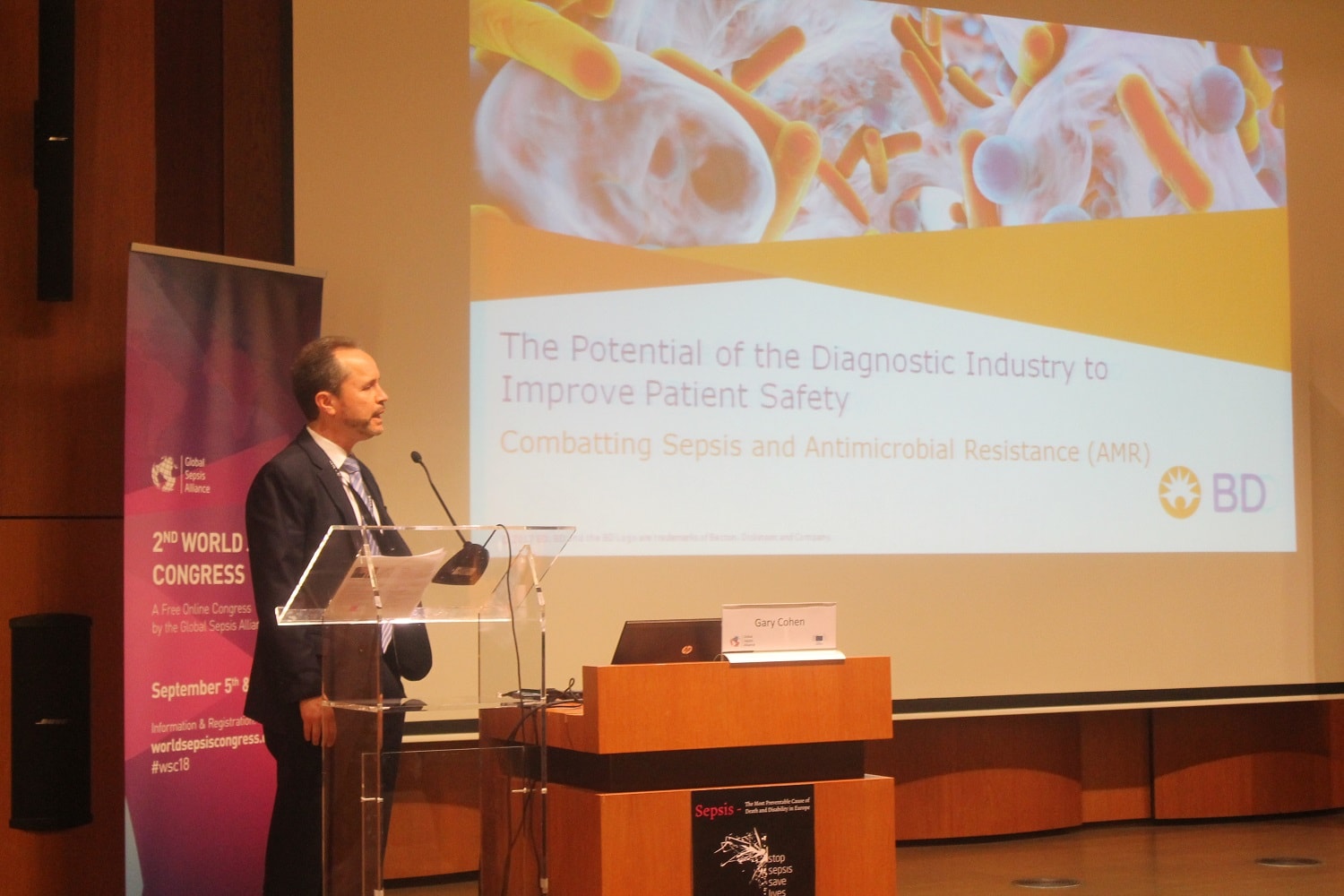As you probably know, a resolution on improving the prevention, diagnosis, and treatment of sepsis was adopted at the Seventieth World Health Assembly in May 2017, spearheaded by the Global Sepsis Alliance and its partners.
This resolution requests the WHO to develop guidance for the prevention and management of sepsis, to produce a report on the epidemiology and burden of sepsis, and to support countries to obtain the necessary infrastructure, laboratory capacity, strategies and tools to address sepsis. The WHO is also expected to work with partners to improve access to quality, safe, efficacious, and affordable treatments for sepsis and tools for infection prevention and control (IPC), including immunization, particularly in developing countries.
In January 2018, experts on sepsis, associated stakeholders and professionals, including several representatives of the Global Sepsis Alliance and the African Sepsis Alliance, participated in a WHO-organized technical expert meeting to discuss sepsis-related issues.
Overall, the meeting aimed to provide support and input for the implementation of the resolution. Its main objectives were to share an overview of current major initiatives on sepsis worldwide, to present WHO activities and plans, to discuss global needs and priorities for action, to gather input on the critical role of WHO and key areas of work, and to explore areas for collaboration between WHO and other key players with the common goal of furthering global efforts on sepsis.
This Saturday, on May 5th, 2018, healthcare facilities, health workers, the World Health Organization, and countless committed partners all around the world celebrate World Hand Hygiene Day, drawing attention to why hand hygiene is so crucially important. This year, the slogan is "It's in your hands - prevent sepsis in healthcare".
Please join us in celebrating World Hand Hygiene Day and preventing sepsis in healthcare this Saturday! To do so, you can participate in our very own Clean Hands Challenge, download and use the WHO's advocacy toolkit, or simply share the information on World Hand Hygiene Day within your network, for example on social media. Material is available in many different languages on the WHO Campaign website.
Although 80 % of sepsis cases are contracted outside of a hospital (see video below), hand hygiene plays a huge role in the prevention of infections, which can quickly lead to sepsis.
Therefore, the WHO urges you to focus on the fight against sepsis in the context of hand hygiene and infection prevention in health care.
Sepsis is estimated to affect more than 30 million patients every year worldwide, and global rates of sepsis are thought to be growing rapidly. At the Seventieth World Health Assembly in May 2017, Member States adopted a resolution on improving the prevention, diagnosis and treatment of sepsis.
The WHO Calls to action are:
- Health workers: “Take 5 Moments to clean your hands to prevent sepsis in health care."
- IPC leaders: “Be a champion in promoting hand hygiene to prevent sepsis in health care.”
- Health facility leaders: "Prevent sepsis in health care, make hand hygiene a quality indicator in your hospital.”
- Ministries of health: "Implement the 2017 WHA sepsis resolution. Make hand hygiene a national marker of health care quality."
- Patient advocacy groups: "Ask for 5 Moments of clean hands to prevent sepsis in health care."
We encourage you and your organization to support World Hand Hygiene Day and prevent sepsis in health care!
The majority of the British public struggle to identify all of the early warning signs of sepsis, according to a national survey by Manchester-based law firm JMW.
Three-quarters (75%) of the 1,057 people questioned by clinical negligence experts JMW said they either didn’t know or were unsure of what the signs of sepsis are. When asked to select the early warning signs from a list, just half (50%) knew that mottled or discoloured skin was a sign, 39% knew about extreme shivering, 35% identified muscle pain as a symptom, and 34% knew that confusion was a signal for sepsis.
Respondents also struggled to correctly identify the remaining symptoms, with just 27% knowing that extreme breathlessness was a sign, 21% knowing that not urinating for at least one day can be a symptom, and only 17% recognising that slurred speech can indicate sepsis.
Eddie Jones, partner and head of clinical negligence at JMW, said: “Following the results of the survey we are concerned about the low numbers of the general public in the UK who could correctly spot the early warning signs of sepsis.
“Any delay in diagnosis can cause increasingly dangerous and long-lasting effects to the afflicted person, and so it is imperative to raise awareness of sepsis and how to identify the symptoms. This could help to ensure early medical intervention for thousands of patients who would otherwise have died or been seriously injured.”
Spotting the Early Warning Signs in Children
Survey respondents were also asked to identify the warning signs of sepsis in children, who exhibit slightly different symptoms than adults. Participants correctly identified fever (51%), having mottled, bluish or pale skin (47%), being lethargic or difficult to wake up (45%), and breathing fast (34%) as signs of sepsis in children.
Only 26% knew that convulsions were a symptom, 23% knew that a rash that doesn’t fade when pressed was a sign, 22% correctly identified a fever, 20% knew that feeling unusually cool to the touch could indicate the condition, and 14% knew that a very low temperature was a symptom.
JMW has partnered with the UK Sepsis Trust to raise awareness by sponsoring the inclusion of a sepsis awareness leaflet in the Bounty Newborn Pack that is given to all new parents of babies delivered in an NHS hospital.
Eddie said: “From our work with the UK Sepsis Trust, we know that raising public awareness of the illness is an ongoing and important mission. To help, we have produced a downloadable poster and an online video animation to give parents, guardians, and other child carers the information they need.”
Melissa Mead, national projector co-ordinator at the UK Sepsis Trust, says: “Sepsis is a terrifying, quick, and deadly condition - not knowing the signs and symptoms could mean the difference between life and death. The results of this survey highlights how much more work there is to be done on raising awareness of sepsis amongst the public.”
In the UK, around 44,000 people lose their life to sepsis every year.
World Meningitis Day raises the global profile of meningitis and shares potentially life-saving information with thousands of people worldwide. This year's theme, #AllMeningitisMatters, raises awareness of the 4 different types of meningitis; bacterial, viral, fungal, and parasitic. It also highlights that multiple vaccines are needed to protect against meningitis because of the variety of bacteria and viruses that can cause it.
Meningitis, of course, is a common source of sepsis.
As an 18-year-old Honours Law student, Maddy was intelligent, beautiful, very independent, wickedly funny with sarcastic undertones (sometimes irreverent) and a great lover of all of God’s creatures, in particular dogs. Maddy was larger than life, a high achiever that typically got what she wanted, through sheer dedication, and perseverance.
Maddy attended the Queensland Tennis School of Excellence at Kelvin Grove State College, during her high school years. She loved the social side of Tennis and was much loved by her Tennis Fraternity. She fought hard in every game to make sure she won as she was very competitive.
After leaving school and whilst attending University, she returned to her love of tennis by coaching young children in the sport at Southern Cross Tennis. This was an extraordinary effort on her part, as she was studying a double degree and working as many hours as she could at Grill’d, to earn her own income.
Maddy amused herself and others with her love of money but in particular what she could buy with money. As a younger teenager we asked Maddy what she wanted to be when she got older, and she replied with great confidence, “I want to be rich”. This was reflected in how determined she was to achieve her best in everything she did. When her nephew came along and started talking, he couldn’t get his tongue around ‘Aunty Maddy’, it came out sounding like ‘Money Money’. From that point on Maddy became affectionately known as ‘Money Money’, and she loved it.
Maddy worked hard, was loved and respected by all those that she worked with, and she enjoyed spending her money on the finer things in life. Maddy was meticulous at looking after herself. She paid attention to her fitness, attended the Gym, spared no expense with her makeup and hair, and it showed. She was a very pretty young lady.
That’s why we are still coming to terms with how, just two weeks shy of her 19th Birthday, Maddy became ill with Influenza, developed pneumonia, and just over one week later, died from Sepsis, in Intensive Care.
On a Thursday afternoon, after spending a few days on the Sunshine Coast with her boyfriend and his family, she came home feeling quite ill and told us that she felt like she was getting the flu. Her Step Mum promptly gave her some Ibuprofen and water and told her to rest.
Maddy’s Dad (that’s me) took her to a GP the following morning (Friday). She was diagnosed with a respiratory infection and told to keep her fluids up, take over the counter cold and flu medication and rest. The next day, Saturday evening, Maddy was feeling worse, she was complaining that she was short of breath, so her Mother took her to the hospital where she was told she was dehydrated, given fluids, and sent home to rest.
She rested Sunday and Monday, we kept up the fluids, soup, and medications and she seemed to be ok. However, by Monday night she complained of feeling very sick. We repeated the advice from the GP and Hospital, told her the flu was going to make her feel terrible and kept up our regime of checking her temperature and administering flu remedies.
We were awake with her all through the night, rubbing her back, trying to make her drink, eat soup, and giving her medications. She only had the flu, right?
Early Tuesday morning Maddy asked me to call her an ambulance. I had an early morning appointment, so I called her Mum who picked her up within 15 minutes and drove her to the hospital.
Maddy was initially diagnosed with severe pneumonia which we were totally shocked at, as she had only been at the hospital two days earlier. By lunch time the same day (Tuesday) she was in an induced coma and we were told she had a 50% chance of survival. Her organs had begun shutting down and she was placed on life support. Things became surreal, and so began our agonising wait to know whether she would pull through or not. We experienced small glimmers of hope, then devastating news. Watching Maddy hooked up to machines on life support was a harrowing experience to say the least.
Maddy’s organs were shutting down and there was no blood reaching her extremities. We were told that if Maddy survived she would become a multiple amputee, losing her hands and feet. How could this be happening to our pretty, fit, outgoing tennis player?
Over the next 10 days we watched our daughter’s body struggle to fight the bacteria. Then, one night at close to 10: 00 pm, her lungs collapsed, the doctors and medical team fought to restore them however Maddy’s body had endured enough. We were there with her as her heart stopped, after such a brave fight, and she left us to be with God. On October 12th, 2017, our lives were changed forever.
We that are left behind, her parents, siblings, boyfriend, wider family, colleagues and friends, are left wondering how, and why, this happened to a fit and healthy, strong and resilient young girl. How do we come to terms with the fact that Maddy is gone?
We are now all slowly learning to live our lives with this unbearable grief and learning about this killer called Sepsis.
Maddy was farewelled at a service where over 800 people overflowed from the church. Yet my guess is that only the medical staff that attended would have heard of, or known anything about, Sepsis.
How could we have not heard about a condition that is responsible for more deaths in Australia than Breast Cancer, Aids, and the road toll combined?
Sepsis, a preventable condition, that if recognised early enough, can be treated successfully. Maddy was not in a high-risk group. Fit healthy 18-year olds get the flu, rest, and recover. We are now left with the question ‘What if we had known about Sepsis?’. Would Maddy still be here? We will never know the answer to that, but I’m confident that the answer is Yes.
Through Maddy’s story, her legacy, she will continue to be an achiever by saving the lives of others. Please educate yourself, your family and friends about Sepsis. Share Maddy’s story. Get the Flu Shot and know the signs of Sepsis. It might not just be the flu. Ask the question ‘Could it be Sepsis?’
As a family, Maddy has left us with beautiful memories. With those memories and through her experience, we want to try and help save the lives of others, we want that to be Maddy’s gift to the world.
The article above was written by Damian Jones, Maddy's father, and is shared here with his explicit consent. The views in the article do not necessarily represent those of the Global Sepsis Alliance. They are not intended or implied to be a substitute for professional medical advice. The whole team here at the GSA & World Sepsis Day wishes to thank Damian & his family for sharing Maddy's story and for fighting to raise awareness of sepsis.
To help us avoid similar stories in the future, please consider donating to support our cause. Thank you.
Every year on May 5th, the World Health Organization and its commited partners all around the world celebrate World Hand Hygenie Day as a call to action for health workers, but also to stimulate the general public for why hand hygenie is so crucially important.
This year, the slogan is "It's in your hands - prevent sepsis in health care".
To honor this special occasion, we are excited to launch the Clean Hands Challenge:
This is a challenge to all health institutions of the world; hospitals, medical schools, nursing or any health area, government offices, laboratories, pharmaceutical companies, and many more. All are invited to participate in order to promote awareness about hand hygiene and sepsis. These are the steps:
- Register your institution (name of the institution, city, country, responsible person and email of the responsible person) using the form above.
- Establish a stand at the entrance to your facility.
- Integrate a team of people (doctor, nurse, resident, fellow...) to train all people who come to your facility on the importance of hand hygiene and explain what sepsis is and how to prevent it (hygiene of hands, vaccination, and proper use of antimicrobials, etc.).
- After a person has received the information, ask them to be registered in a list along with their email (explain that the emails will be used to send information about World Sepsis Day and promote awareness about sepsis, but only if the check the field on the right).
- Take a lot of pictures and upload them to social networks with the hashtag #HandHygiene, #Sepsis #(YourCountry) @WorldSepsisDay
- Send us the record of all the people who were trained during these days, per email to office@world-sepsis-day.org, with the topic "Clean Hands Hygenie).
All participating institutions that demonstrate their activities will receive a certificate and the institutions with the most activity will be named winners of this challenge.
What are you waiting for? It’s in your hands prevent sepsis in health care!
Sepsis affects around 30 million people every year, with 6 to 9 million deaths. That means more than 21 million people survive sepsis every year. Many suffer from the consequences for the rest of their lives. Some of the consequences are obvious, such as missing limbs or organ dysfunction, like kidney failure. Some are less obvious, such as memory loss or post-traumatic stress disorder (PTSD).
Our friends from the Sepsis Alliance and the Society of Critical Care Medicine have made a short 4-min video on life after sepsis - we highly recommend watching it!
On Tuesday, March 20th, 2018, the Global Sepsis Alliance, under the patronage of the EU Commissioner for Health & Food Safety, Vytenis Andriukaitis, hosted the event 'Sepsis - The Most Preventable Cause of Death and Disability in Europe - A Call to EU Action' in Brussels, Belgium. More than 120 people from different backgrounds and nationalities participated and enjoyed the keynote of Commissioner Andriukaitis and the presentations of Edward Kelley, Director Service Delivery and Safety from the WHO, Konrad Reinhart, Chair of the Global Sepsis Alliance, Ron Daniels, Founder and CEO of the UK Sepsis Trust, and Gary Cohen, President of Global Health from BD, as well as the personal story of Dennis Kredler, who is a sepsis survivor. All presentations can be downloaded below.
In the second part of the event, we founded the European Sepsis Alliance (ESA), which aims to unite European GSA Members and develop and implement a Pan-European sepsis strategy. In four working groups (Quality Improvement of Early Diagnosis and Management, Awareness Raising and Lobbying, Patient and Family Advocacy, and Research), we laid the foundation for this important milestone.
Before closing, the participants, representing major European stakeholders in the fight against sepsis, unanimously adopted The Brussels Sepsis Resolution (download below), which urges the European Commission, Council of Ministers, and the European Parliament:
To endorse the WHO Resolution on Sepsis and to encourage all European countries accordingly to develop national Action Plans and strategies to improve prevention, recognition, management, and rehabilitation of sepsis;
To support a comprehensive Pan-European infection management strategy with sepsis as a key element
To promote awareness on sepsis by organizing an European Sepsis Week around World Sepsis Day (September 13th)
To encourage and support the European Center for Disease Control (ECDC) to engage in sepsis education for citizens and healthcare professionals following the shining example of the Centers for Disease Control and Prevention in the US and similar initiatives in the UK and elsewhere,
To consider the inherent links between AMR, ICP and sepsis in the new resolution of the EU Parliament to tackle antimicrobial resistance;
To expand existing EU research programs on Infection control and AMR to better understand the human, medical, and economic burden of sepsis for Europe and to support the development of innovations to shorten and improve the diagnosis and management of sepsis and reduce the burden of its sequelae for survivors
To become involved in the European Sepsis Alliance, please get in touch.
